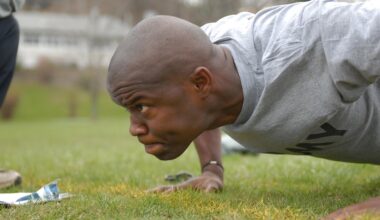Targeting Different Arm Muscles with Bodyweight Exercises
Bodyweight exercises are an excellent way to build arm strength without the need for weights or complicated equipment. They can be performed anywhere, making them a convenient option for those looking to tone and strengthen their upper body. To effectively target different arm muscles, it’s essential to understand the primary muscle groups involved, including the biceps, triceps, and shoulders. Each group can be engaged through various movements like push-ups, dips, and planks. Additionally, incorporating different variations of these exercises will ensure continued progress and muscle engagement. For example, changing hand positions while doing push-ups can shift the focus from the chest to the triceps. Similarly, adding a challenging element like single-leg variations can increase the intensity of the workout. Some helpful tips include maintaining proper form and gradually increasing rep counts for continuous improvement. Not only do these exercises enhance physical appearance, but they also improve functional strength, making everyday tasks easier. Creating a structured routine that incorporates these movements will yield significant results over time, making bodyweight exercises a wise choice for arm strength training.
Diving Deeper into Push-Ups
Push-ups are a foundational bodyweight exercise targeting multiple muscles in the arms, particularly the chest, shoulders, and triceps. Proper form includes keeping your body in a straight line, lowering yourself until your chest nearly touches the floor, and pushing back up explosively. Variations like wide grip push-ups emphasize the chest, while close grip push-ups focus more on the triceps. You can also try plyometric push-ups for an explosive twist to enhance strength and power. Each variation significantly engages different muscle fibers, promoting balanced development and preventing injuries. Moreover, you can increase difficulty by elevating your feet to shift more weight onto your arms and shoulders. Strengthening stabilizer muscles while performing push-ups can help improve overall power and endurance. You can incorporate push-ups into your routine three to four times weekly for best results. Gradually increasing reps or adding difficulty provides continual challenges for your muscles. Keeping track of progress helps maintain motivation and positive results. Remember to combine push-ups with other complementary movements to work all muscle groups effectively. Consistent practice will surely lead to enhanced arm strength and definition.
Another effective bodyweight exercise is the dip, primarily targeting the triceps and shoulders. Dips can be performed on parallel bars or simply on a sturdy surface like a bench or chair. To execute a dip, start by sitting on the edge, gripping the surface, and extending your legs. Lower yourself down by bending your elbows, then push back up to starting position. Ensure your elbows stay close to your body to maximize tricep engagement. Variations include narrow grip dips that focus on the triceps and wider grips for shoulder engagement. By adjusting your leg position, you can modify the intensity of the exercise to suit your fitness level. For example, keeping your feet on the ground makes the movement easier, while extending your legs out increases difficulty significantly. One brilliant idea is to perform dips in a circuit with push-ups and planks to target the entire arm and core effectively. Ensure full range of motion in each rep to reap maximum benefits. Integrating dips into your arm training routine will lead to improved muscle tone and strength over time, making it an essential addition.
Enhancing Arm Strength with Planks
Planks are often overlooked but are an incredibly effective core exercise that also strengthens the arms. They engage the shoulders, triceps, and upper body overall as stabilizing muscles, making them critical for balanced strength. To perform a plank, start in a push-up position, maintaining a straight line from head to heels. Hold the position while engaging your core and squeezing your glutes. There are multiple variations to keep things interesting, such as side planks which target the obliques and shoulders. To increase difficulty, try dynamic planks incorporating leg lifts or shoulder taps. These variations not only challenge your balance but also develop functional strength. Regular practice of planks promotes endurance and stability, both critical components of overall fitness. They can be combined with other arm exercises to create a well-rounded workout. Aim for holding planks for at least 30 seconds, gradually working toward longer durations. Incorporating planks into your weekly routine will lead to visible improvements in arm strength and stability, essential for performing daily activities with ease. Don’t neglect this powerful exercise for building stronger arms!
Another great choice for arm strength training is the inverted row, primarily targeting the biceps and back muscles. This exercise requires pulling your own body weight towards an elevated bar or TRX system. Begin by lying underneath the bar, gripping it with an overhand grip, and straightening your body. Pull yourself up until your chin reaches the bar, maintaining a straight body line throughout the movement. Adjusting your foot positioning alters the exercise’s intensity; knees bent makes it easier, while extending legs straight increases difficulty. Inverted rows not only develop the biceps effectively but also enhance grip strength, essential for various activities. A set of three-to-four rounds with 10-15 reps will provide ample strength development. Integrating inverted rows into your routine will promote balanced muscle growth and overall body strength. It is essential to rest between sets to recover fully and maintain performance. This is a versatile exercise that adapts easily to different fitness levels by offering various grip options and body angles. Regular practice will lead to noticeable strength gains and improved arm definition over time, making it a must in any training program.
Combining Bodyweight Exercises for Optimal Results
Combining different bodyweight exercises into a comprehensive arm training program can lead to optimal results. A well-structured routine should address all muscle groups in the arms, ensuring balanced development and overall strength. Start with compound movements like push-ups and dips for overall engagement, followed by isolation exercises such as bicep curls with body-weight equivalents. Incorporating plyometric exercises like explosive push-ups can further challenge your muscles and encourage growth. Organize your workout into three to four sets, focusing on different exercises in each round to maintain intensity. Aim for 15 to 20 repetitions for each exercise, adjusting as necessary to match your fitness level. Mixing it up with a variety of exercises keeps your program interesting, which can enhance motivation and adherence. Don’t forget to include proper warm-ups and cooldown stretches to prevent injuries and aid recovery. Maintaining a consistent workout schedule will lead to visible gains in arm strength and endurance. Track your progress by recording repetitions and adjusting your routine as your fitness improves. Embracing the versatility of bodyweight exercises will maximize your arm training potential over time.
After understanding the importance of targeting different arm muscles with bodyweight exercises, embracing their benefits can significantly impact your fitness routine. These exercises require no equipment and can be adapted to suit beginners to advanced levels, providing substantial versatility. Engaging in bodyweight workouts can promote better muscle coordination, functional strength, and stability, essential for overall fitness. Furthermore, they improve body awareness and control, enhancing performance in various sports and daily tasks. To maximize the effectiveness of your routine, focus on proper technique and form, ensuring each movement engages the targeted muscle group efficiently. Programs should be tailored to include a mix of all muscle engagement methods, as discussed earlier, for holistic development. Adopting a balanced approach can generate better muscle growth and improved performance over time. Consistency is crucial in yielding effective results, so scheduling workouts and sticking to them will maintain motivation. Exploring new variations and incorporating challenges can prevent plateaus, ensuring continual progress. Ultimately, bodyweight exercises contribute to improved arm strength, appearance, and overall fitness levels, making them an invaluable addition to any fitness journey.


